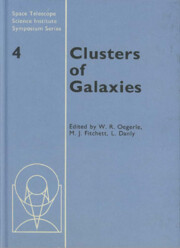Book contents
- Frontmatter
- Contents
- Preface
- Participants
- Chapter 1 Cosmology and Cluster Formation
- Chapter 2 Clusters of Galaxies: Structure, Infall, and Large-Scale Distribution
- Chapter 3 Cosmogony with Clusters of Galaxies
- Chapter 4 Cosmogony and the Structure of Rich Clusters of Galaxies
- Chapter 5 The Dark Matter Distribution in Clusters
- Chapter 6 The Effect of the Cluster Environment on Galaxies
- Chapter 7 Evidence for Gas Deficiency in Cluster Galaxies
- Chapter 8 Properties of Galaxies in Groups and Clusters
- Chapter 9 Dynamical Evolution of Clusters of Galaxies
- Chapter 10 Hot Gas in Clusters of Galaxies
- Chapter 11 Hydrodynamic Simulations of the Intracluster Medium
- Chapter 12 Evolution of Clusters in the Hierarchical Scenario
- Chapter 13 Distant Clusters as Cosmological Laboratories
- Chapter 14 Future Key Optical Observations of Galaxy Clusters
- Chapter 15 Cluster Research with X-ray Observations
- Plate section
Chapter 10 - Hot Gas in Clusters of Galaxies
Published online by Cambridge University Press: 06 July 2010
- Frontmatter
- Contents
- Preface
- Participants
- Chapter 1 Cosmology and Cluster Formation
- Chapter 2 Clusters of Galaxies: Structure, Infall, and Large-Scale Distribution
- Chapter 3 Cosmogony with Clusters of Galaxies
- Chapter 4 Cosmogony and the Structure of Rich Clusters of Galaxies
- Chapter 5 The Dark Matter Distribution in Clusters
- Chapter 6 The Effect of the Cluster Environment on Galaxies
- Chapter 7 Evidence for Gas Deficiency in Cluster Galaxies
- Chapter 8 Properties of Galaxies in Groups and Clusters
- Chapter 9 Dynamical Evolution of Clusters of Galaxies
- Chapter 10 Hot Gas in Clusters of Galaxies
- Chapter 11 Hydrodynamic Simulations of the Intracluster Medium
- Chapter 12 Evolution of Clusters in the Hierarchical Scenario
- Chapter 13 Distant Clusters as Cosmological Laboratories
- Chapter 14 Future Key Optical Observations of Galaxy Clusters
- Chapter 15 Cluster Research with X-ray Observations
- Plate section
Summary
Abstract. This contribution reviews the X-ray properties of clusters of galaxies and includes a brief summary of the X-ray characteristics of early-type galaxies and compact, dense groups. The discussion of clusters of galaxies emphasizes the importance of X-ray observations for determining cluster substructure and the role of central, dominant galaxies. The X-ray images show that substructure is present in at least 30% of rich (Abell) clusters and, hence that many rich clusters whose other properties are those of dynamically young systems, suggests that most cluster classification systems which utilize a property related to dynamical evolution, require a second dimension related to the dominance of the central galaxy. X-ray surveys of rich clusters show that central, dominant galaxies are twice as common as optical classifications suggest. The evidence for mass deposition (“cooling flows”) around central, dominant galaxies is reviewed. Finally, the implications of X-ray gas mass and iron abundance measurements for understanding the origin of the intracluster medium are discussed.
HOT GAS IN GALAXIES, GROUPS, AND CLUSTERS
Hot gas has been been found to be commonly associated with both individual early-type galaxies and with the poor and rich clusters in which they lie. Although this presentation will concentrate on the hot gas in rich clusters, we briefly describe the characteristics of individual galaxies and groups, as well as clusters since their evolution and present epoch properties are interrelated. Recent reviews of X-ray properties of clusters of galaxies include Forman and Jones (1982) and Sarazin (1986).
- Type
- Chapter
- Information
- Clusters of Galaxies , pp. 257 - 286Publisher: Cambridge University PressPrint publication year: 1990
- 18
- Cited by



